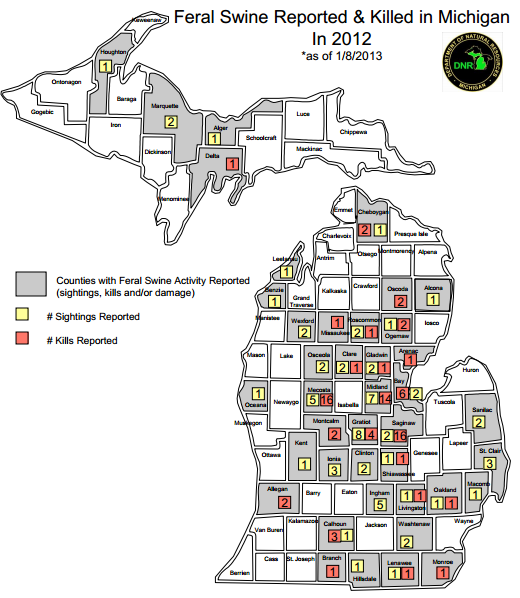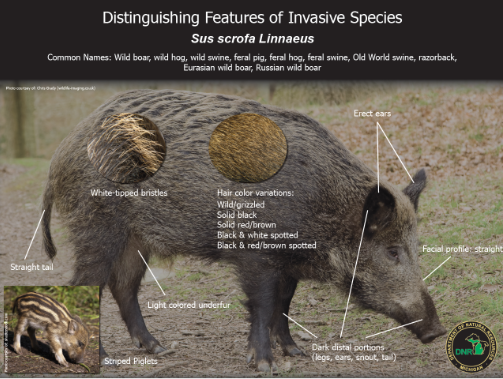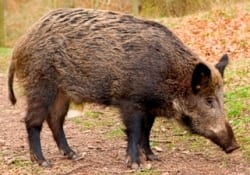The proclaimed impetus for issuing the swine Invasive Species Order (ISO) is that there is a problem with feral swine in Michigan; but is it really a problem in Michigan or is it Invasive Hype?
Michigan Map: Feral Swine Reported & Killed Sightings in 2012
The Michigan Legislature had already passed a ‘shoot-on-sight’ law in 2010 to address the feral swine issue; judging from the numbers of sightings and kills, there really is no feral swine problem in Michigan as compared to other states like Texas. Michigan has been tracking reports of feral swine sightings and killings since at least 2001.
View the Feral Swine Sighting Report (Updated 8/5/2013) at http://michigan.gov/documents/dnr/FS_sightings_kill_8_05_13_only_430247_7.pdf

Map Source: http://michigan.gov/documents/dnr/2012FSMap_010813_409803_7.pdf |
Print Map — Michigan Feral Swine Reported (Updated 1/8/2013)
Print PDF — Feral Swine Sighting Report (Updated 8/5/2013)
The Michigan Department of Natural Resources issued an Invasive Species Order (ISO) in 2010 to go into effect April 2012, claiming to address the ‘feral swine problem’ in Michigan. In December 2011 a Declaratory Ruling was issued to clarify how DNR intended to identify prohibited swine. Unfortunately, the ISO targets a pig by “species” rather than whether than whether it is feral or not.
Prohibited Swine: Distinguishing Features Per MDNR
The Declaratory Ruling was issued in December 2011 in answer to the question of what are “the exact standards that MDNR will be utilizing to determine the hybrid, genetic variants and offspring of prohibited swine.”
Prohibited Species, per Declaratory Ruling:
-
Wild boar, wild hog, wild swine, feral pig, feral hog, feral swine, Old world swine, razorback, eurasian wild boar, Russian wild boar (Sus scrofa Linnaeus). This subsection does not and is not intended to affect sus domestica involved in domestic hog production.

Print Image or
View Image at www.michigan.gov/documents/dnr/Feral_swine_photo_illustration_381452_7.pdf
Instead of genotyping, DNR will use phenotyping “to identify Sus scrofa and distinguish it from other species. Identification may include use of one or more of the following characteristics:” [underlining added]
- Bristle-tip coloration
- [Distal] “Point” coloration
- Coat coloration
- Underfur
- Juvenile coat pattern
- Skeletal appearance
- Tail structure
- Ear structure
- Other characteristics not currently known
Heritage hog breeders are caught in the cross-hairs; hybrids, genetic variants and offspring will be considered “prohibited swine” if any of the phenotype characteristics are observed. Most notable are the ambiguous characteristics: ear structure (“erect or folded/floppy”–what else is there?) and tail structure (“curly or straight”–again, what else is there?).
DNR: Rules for Shooting Feral Swine
What is a feral swine?
A feral swine is a free-ranging pig. Feral swine are considered exotic, nuisance species and cause damage to agricultural lands and the environment. Feral swine can also have negative impacts on wildlife and livestock.
Is it legal to take feral swine?
Yes, if you are legally hunting game during an open season (of any type) and see a feral swine you may pursue that animal if you wish, following all the regulations of the open season which you are hunting. (Please note: There is an open season of some species 365 days of the year.) For open seasons and regulations, please view the most current Michigan Hunting and Trapping Digest.
What is the new law, Public Acts 69-71 of 2010?
The new law does not establish a hunting season on feral swine. Public Acts 69-71 of 2010 declare feral swine a nuisance species and allow for the opportunistic take of any free-ranging pig running at large. Under this law, a person with a concealed pistol permit (CPL) or valid hunting license can kill swine running at large on public property; landowners or other authorized persons can kill swine running at large on private property; and local animal control officers and law enforcement can kill swine running at large on either public or private property.
When can I legally shoot a feral swine?
Any time during regular hunting hours and when actively night-hunting raccoon, opossum, fox and coyote. (Please be sure to follow all day and night hunting regulations for the season in which you are hunting game. Refer to the current Michigan Hunting and Trapping Digest for details.)
What type of hunting license do I need to pursue feral swine?
Any type of valid hunting license or a concealed pistol permit is needed on public property. Possession of either of these allows the holder to be in legal possession of the firearm associated with the license or permit on public land.
If I have a CPL, do I also need a hunting license?
No, you do not need a hunting license in conjunction with the CPL.
Can I shoot feral swine on private property?
If you are the landowner or have permission of the landowner, you may shoot feral swine on private property at any time. It is not necessary to possess a hunting license or CPL to kill feral swine on private land.
Source: http://michigan.gov/dnr/0,4570,7-153-10370_12145_55230-230093–,00.html
ANIMALS RUNNING AT LARGE
(EXCERPT)
Act 328 of 1976
433.14a Public nuisance; authority to kill swine running at large; prohibition.
Sec. 4a.
(1) Swine running at large on public or private property are a public nuisance.
(2) A local animal control officer appointed under the dog law of 1919, 1919 PA 339, MCL 287.261 to 287.290, or a law enforcement officer may kill a swine running at large on public or private property.
(3) A person who possesses a license to carry a concealed pistol issued under 1927 PA 372, MCL 28.421 to 28.435, or a valid hunting license for any game issued under part 435 of the natural resources and environmental protection act, 1994 PA 451, MCL 324.43501 to 324.43561, may kill a swine running at large on public property. A person may kill swine running at large on private property if the person is, or is accompanied by or has the permission of, the owner or lessee of the property.
(4) Subsection (3) does not authorize the discharge of a bow and arrow, crossbow, or firearm in an area where the discharge of that weapon, or hunting with that weapon, is prohibited by an ordinance adopted pursuant to part 419 of the natural resources and environmental protection act, 1994 PA 451, MCL 324.41901 to 324.41905.
History: Add. 2010, Act 69, Imd. Eff. May 13, 2010
Print PDF – Animals Running at Large
